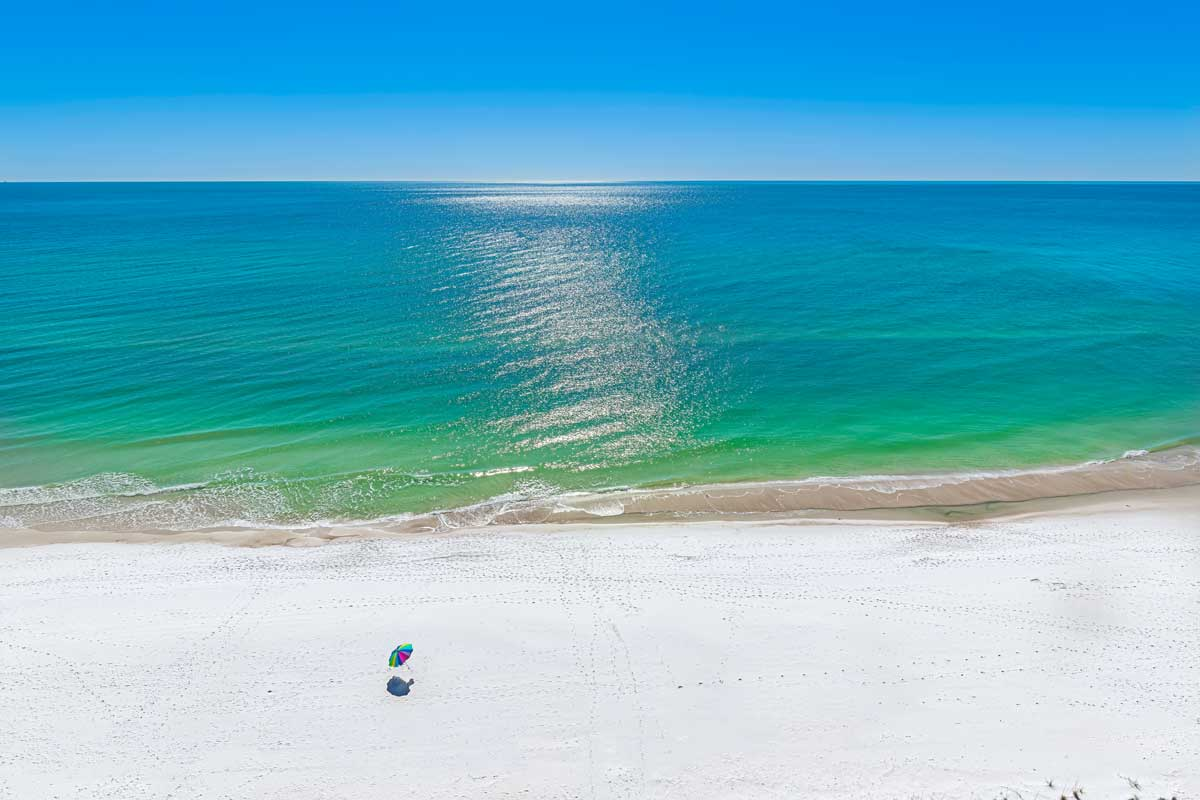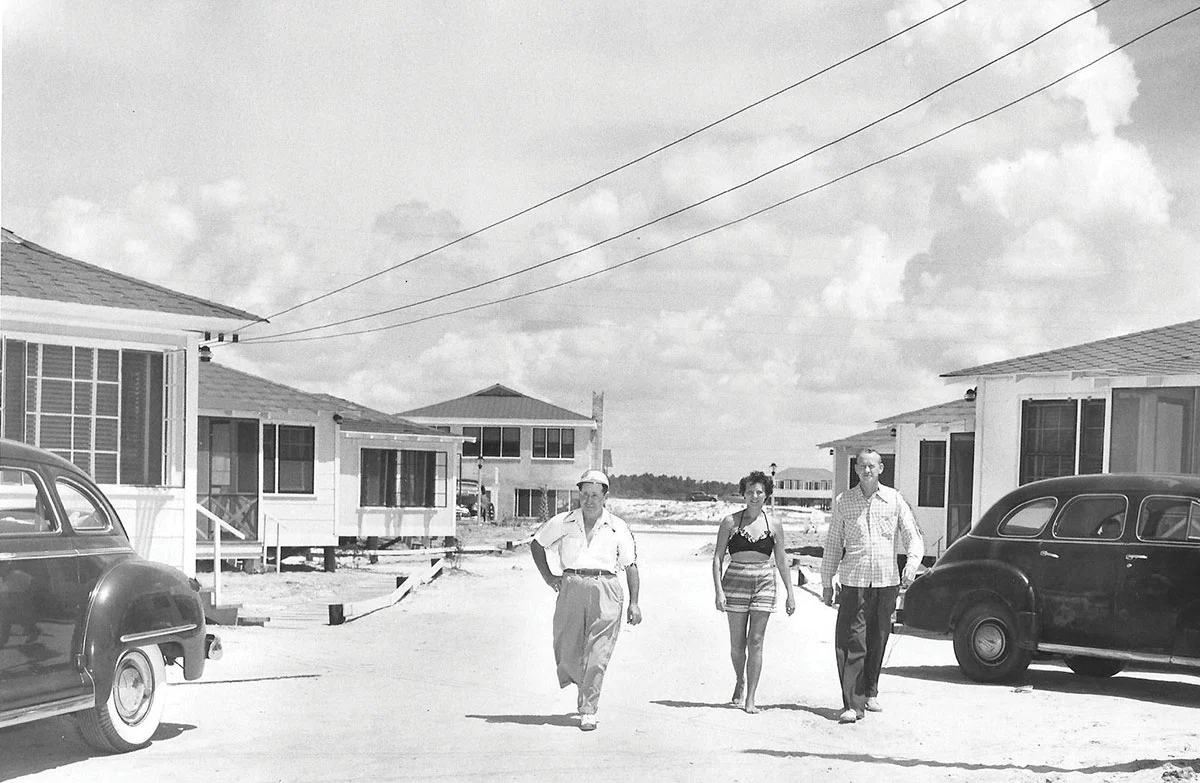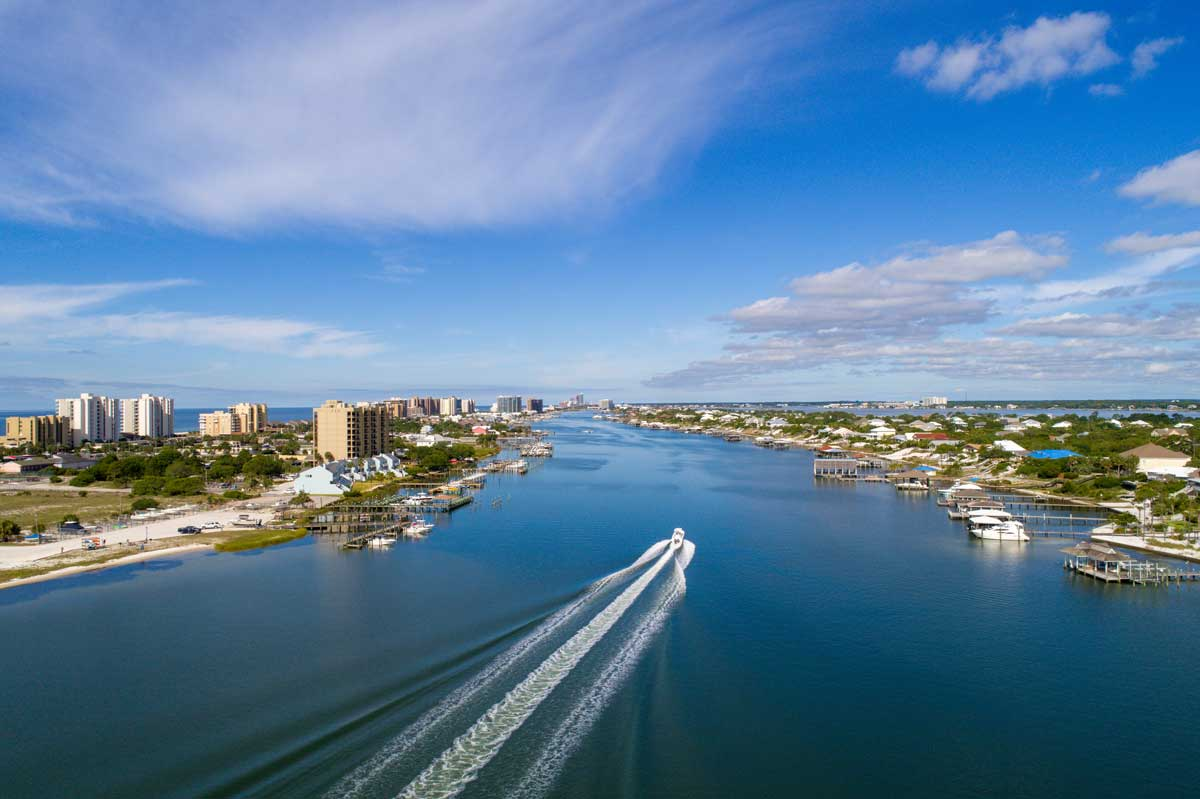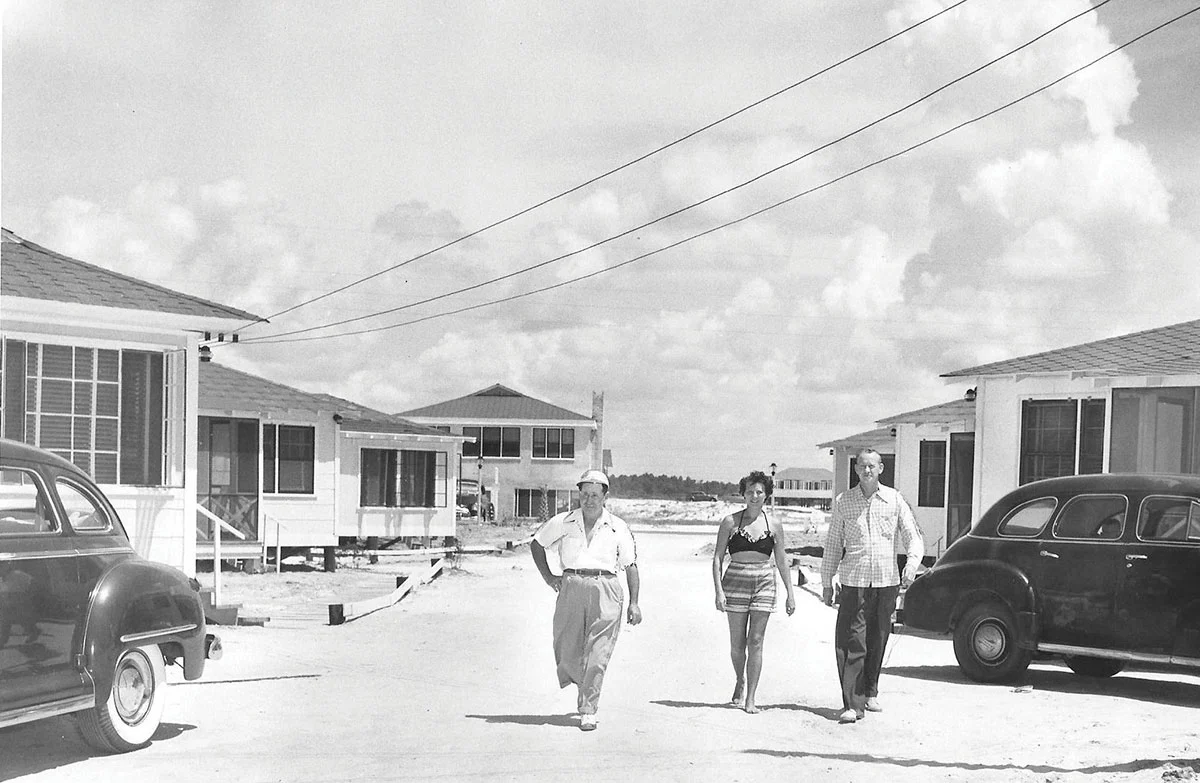Once home to Native American tribes and later a sleepy fishing village, Gulf Shores evolved into a beloved beach destination after WWII. Boosted by tourism, it grew rapidly—surviving hurricanes, developing attractions, and embracing eco-tourism. Today, it blends small-town charm with Gulf Coast beauty.
I don’t know about you, but I’m a bit of a history buff. Whenever I travel—whether it’s to the Rocky Mountains or the North Carolina coast—I like to dig into the local past.
And I enjoy writing about it, too. This time, I took a deep dive into the history of one of my favorite destinations: Gulf Shores, Alabama. Can you believe that In 1956, Gulf Shores had just 120 inhabitants?! 😮
The full story’s laid out below in details, but here’s the gist of it:
- Early Inhabitants: Creek, Choctaw, and Seminole tribes thrived on local natural resources.
- European Contact: Spanish explorers arrived in 1519; area changed colonial hands before becoming U.S. territory
- City Origins: Founded in the mid-1800s; incorporated as "Gulf Shores" in 1958
- Early Economy: Fishing and agriculture dominated—shrimp, citrus, peanuts.
- WWII Boost: Military bases introduced many to the area; post-war tourism surged.
- Tourism Growth: 1950s–60s boom with family travel, Gulf State Park, and beachside development.
- Storm Resilience: Rebuilt after major hurricanes, notably Frederic (1979) and Ivan (2004).
- Infrastructure Expansion: Highways and Jack Edwards Airport made travel easier.
- Diversified Attractions: From zoos to golf and music festivals like Hangout.
- Culinary & Festivals: Shrimp Festival (1971) and fresh seafood define its food scene.
- Eco-Conscious: Wildlife refuges, turtle conservation, and "Leave Only Footprints" lead sustainability efforts.
At Vacation Homes Collection, we're experts in the area (if I can say so myself!), so be sure to check out our blog for tips on making the most of your trip. Whether you're looking for a guide to a great weekend or a bucket list of activities, we've got all in there.
In this article, I'll take you on a fascinating journey from the early history of Gulf Shores, Alabama to its present state as a popular destination for vacations and all kinds of fun and entertainment.
Time to rewind the clock. 🕒

1. Early Days and Native American Influence
Long before Gulf Shores became the popular tourist spot we know today, the area was home to various Native American tribes. The region's earliest inhabitants included the Creek, Choctaw, and Seminole peoples.
These tribes thrived on the abundant natural resources of the Gulf Coast, taking advantage of the rich fishing grounds and fertile lands.
They left behind shell middens, pottery shards, and other artifacts that give us glimpses into their way of life. The warm climate and bountiful waters made the Gulf Shores area an ideal place for these early inhabitants to settle and flourish.
Key Takeaways:
-
Native tribes like the Creek, Choctaw, and Seminole first inhabited Gulf Shores.
-
The area’s natural resources supported thriving early communities.
-
Archaeological finds show thousands of years of settlement.
-
Warm climate and abundant waters made it an ideal home.
2. Spanish Exploration and Early European Settlement
The first Europeans to set foot in what would become Gulf Shores were Spanish explorers in the early 16th century. In 1519, Alonso Álvarez de Pineda led an expedition that mapped the Gulf Coast, including the area around present-day Gulf Shores. This marked the beginning of European interest in the region.
However, it wasn't until the 18th century that permanent European settlements began to take root.
The area changed hands several times between the Spanish, French, and British before ultimately becoming part of the United States following the Louisiana Purchase in 1803.
Early settlers faced numerous challenges, including hurricanes, disease, and conflicts with Native American tribes. Despite these obstacles, they persevered, drawn by the area's natural beauty and potential for agriculture and trade.
-
Spanish explorers arrived in the Gulf Shores area in 1519, led by Alonso Álvarez de Pineda.
-
European interest began early, but permanent settlements didn’t appear until the 1700s.
-
Control of the area shifted between Spanish, French, and British powers.
-
It became part of the U.S. after the Louisiana Purchase in 1803.
-
Early settlers endured storms, disease, and conflict but stayed for the land’s promise.

3. The Birth of Gulf Shores
The actual founding of Gulf Shores as we know it today can be traced back to the mid-19th century. In 1840, a group of investors purchased land in the area and began developing it for residential and commercial use.
They saw potential in the pristine beaches and believed that people would be drawn to the natural beauty of the Gulf Coast.
The town's name, "Gulf Shores," was officially adopted in 1958 when it was incorporated as a city. This name perfectly captured the essence of the community – a place where the shores of the Gulf of Mexico met civilization.
Key Takeaways:
- Gulf Shores began taking shape in the mid-1800s with land purchased for development in 1840.
- Early developers were drawn to the area's natural coastal beauty.
- The name “Gulf Shores” was officially adopted in 1958 upon incorporation as a city.
- The name reflects the town’s identity as a coastal community.
4. Early Economy: Fishing and Agriculture
In its early years, Gulf Shores' economy revolved primarily around fishing and agriculture. The abundant waters of the Gulf of Mexico provided a rich source of seafood, including shrimp, oysters, and various fish species.
Local fishermen built a thriving industry, supplying fresh catches to nearby markets and beyond.
Agriculture also played a significant role in the area's early economy. Farmers cultivated crops suited to the coastal climate, such as sweet potatoes, peanuts, and citrus fruits. These agricultural pursuits helped sustain the growing community and attract more settlers to the region.
5. The Impact of World War II
World War II brought significant changes to Gulf Shores and the surrounding area. The U.S. military recognized the strategic importance of the Gulf Coast and established several bases and training facilities in the region.
This influx of military personnel introduced many people to the beauty of Gulf Shores for the first time.
After the war, many veterans who had trained or been stationed in the area returned to settle permanently or vacation with their families.
This post-war period marked the beginning of Gulf Shores' transformation into a tourist destination.
Key Takeaways:
-
During WWII, Gulf Shores gained strategic importance, leading to new military bases and training sites.
-
The military presence introduced many to the area’s natural beauty.
-
After the war, veterans returned as residents and vacationers.
-
This period marked the start of Gulf Shores’ evolution into a tourism hub.
6. The Rise of Tourism
The 1950s and 1960s saw a boom in tourism for Gulf Shores. As Americans became more prosperous and car ownership increased, families began taking road trips to coastal destinations.
Gulf Shores, with its stunning white-sand beaches and warm waters, quickly became a popular choice for vacationers.
The development of attractions like the Gulf State Park in 1939 (though it would be decades before it reached its full potential) added to the area's appeal.
Key Takeaways:
-
Gulf Shores became a road-trip favorite in the 1950s–60s, thanks to rising prosperity and its inviting beaches.
-
Tourism transformed the town, with new businesses and attractions like Gulf State Park boosting its appeal.
7. Weathering the Storms
Gulf Shores' path to popularity hasn't been without its challenges. The town has faced numerous hurricanes over the years, each leaving its mark on the landscape and the community.
Notable storms include Hurricane Frederic in 1979 and Hurricane Ivan in 2004, which caused significant damage to the area.
However, these natural disasters have also showcased the resilience of Gulf Shores and its residents. After each storm, the community has come together to rebuild, often emerging stronger and more appealing to visitors than before.
This ability to bounce back has become a point of pride for locals and a testament to the enduring appeal of Gulf Shores.
Key Takeaways:
-
Gulf Shores has weathered major hurricanes like Frederic (1979) and Ivan (2004), which caused serious damage.
-
Each recovery has highlighted the town’s resilience, strengthening its charm and community spirit.
8. Developing Infrastructure
As Gulf Shores grew in popularity, so did the need for improved infrastructure. The construction of better roads, including the expansion of Highway 59, made the town more accessible to visitors from across the country.
The opening of Jack Edwards National Airport (formerly Gulf Shores Airport) in 1967 further enhanced transportation options.
The development of utilities, schools, and healthcare facilities supported the growing permanent population, which in turn allowed for a more robust tourism industry.
This symbiotic relationship between resident needs and visitor amenities has been crucial to Gulf Shores' success.
Key Takeaways:
-
Improved roads and the opening of Jack Edwards Airport made Gulf Shores more accessible to tourists.
-
Infrastructure growth supported both residents and visitors, fueling long-term tourism success.

9. Diversifying Attractions
While the beautiful beaches remain the primary draw for many visitors, Gulf Shores has worked hard to diversify its attractions over the years. The Alabama Gulf Coast Zoo, which opened in 1989, has become a popular family destination.
Golf courses, such as the Gulf Shores Golf Club (established in 1960), have attracted enthusiasts of the sport.
The addition of water parks, mini-golf courses, and go-kart tracks has provided entertainment options for visitors of all ages. These varied attractions have helped Gulf Shores appeal to a broader range of tourists and encourage longer stays.
Key Takeaway:
- Gulf Shores added attractions like a zoo and golf to boost appeal and lengthen visits.
10. Culinary Scene and Festivals
Gulf Shores' culinary scene has evolved significantly, becoming a major part of its appeal. Restaurants showcasing fresh, local seafood have proliferated, offering visitors a taste of authentic Gulf Coast cuisine.
The Annual National Shrimp Festival, first held in 1971, has grown into a major event that draws thousands of food lovers each year.
Other festivals and events, such as the Hangout Music Festival (launched in 2010), have put Gulf Shores on the map for a new generation of visitors. These events not only attract tourists during peak seasons but also help to extend the tourist season into traditionally slower periods.
Key Takeaway:
- Seafood spots and festivals like the Shrimp Festival and Hangout have made Gulf Shores a year-round draw.
11. Environmental Conservation Efforts
As Gulf Shores has grown, so has the awareness of the need to protect its natural beauty. Conservation efforts have become an important part of the town's identity and appeal.
The establishment of Bon Secour National Wildlife Refuge in 1980 has helped preserve critical habitats for migratory birds and endangered species like the Alabama beach mouse.
Efforts to protect sea turtle nesting sites have become a point of interest for environmentally conscious visitors. The Leave Only Footprints initiative, launched in recent years, encourages beachgoers to keep the shores clean and preserve the natural environment for future generations.
These conservation efforts have not only helped maintain the area's natural beauty but have also attracted eco-tourists interested in experiencing unspoiled coastal environments.
Key Takeaways:
-
Gulf Shores prioritizes conservation, with efforts like sea turtle protection and the Bon Secour Wildlife Refuge.
-
Initiatives like Leave Only Footprints appeal to eco-tourists and help preserve the area's natural charm.

From Quiet Shores to Tourist Treasure
Gulf Shores, Alabama, has transformed from a quaint fishing village into a bustling tourist destination over the years.
More than 8 million people visit the Alabama Gulf Coast each year, which includes cities such as Orange Beach, Fort Morgan, and of course, Gulf Shores.

Stay Like a Local in Gulf Shores, Orange Beach, & Fort Morgan
With years of experience in Gulf Shores and Orange Beach, we at Vacation Homes Collections don’t just know the best events in town and the top attractions on Alabama's Gulf Coast — we’re also experts in crafting unforgettable experiences.
Our, vacation rentals, ranging from beachfront homes to high-rise condos, provide the perfect home base for your next Alabama Gulf Coast getaway.
When you stay with us, all you need to do is soak in the coastal beauty and let it whisk you away — because it surely will! ✨



